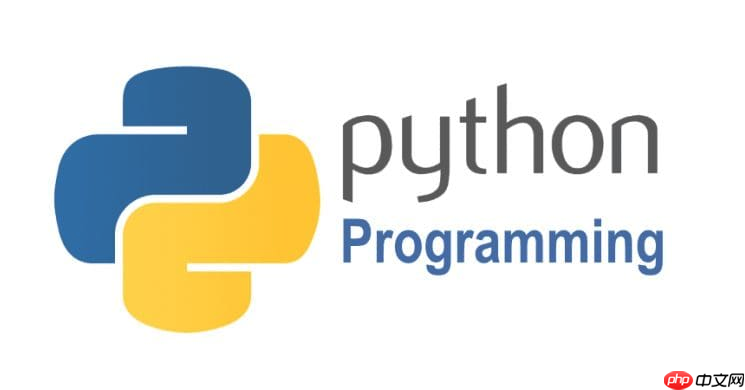在python中實現模板方法模式需定義包含算法骨架的抽象類,并將部分步驟延遲到子類中實現。1. 定義一個抽象基類,其中包含一個模板方法,該方法定義了算法的執行順序;2. 模板方法調用一些抽象方法,這些方法必須在子類中實現;3. 基類可提供具體方法供子類使用或重寫;4. 子類實現變化的步驟,保持算法整體結構不變。例如,abstractclass定義了template_method按照step_one、step_two、step_three順序執行,其中前兩個為抽象方法需子類實現,step_three可被子類重寫。模板方法模式的優點是避免代碼重復,將公共邏輯放在基類,變化部分交由子類實現,但缺點是增加類數量從而可能提升系統復雜度。

在python中實現模板方法模式,核心在于定義一個包含算法骨架的抽象類,并將某些步驟延遲到子類中實現。這樣既保證了算法的整體結構不變,又允許子類定制特定的實現細節。設計模式在框架設計中扮演著至關重要的角色,它們提供了一套經過驗證的、可復用的解決方案,用于解決軟件設計中常見的難題,從而提高代碼的可維護性、可擴展性和可讀性。

解決方案:

模板方法模式的關鍵在于定義一個抽象基類,其中包含一個模板方法,這個方法定義了算法的執行順序。模板方法會調用一些抽象方法,這些抽象方法需要在子類中實現。同時,基類也可以提供一些具體的實現方法,供子類直接使用或重寫。
立即學習“Python免費學習筆記(深入)”;
from abc import ABC, abstractmethod class AbstractClass(ABC): def template_method(self): self.step_one() self.step_two() self.step_three() @abstractmethod def step_one(self): pass @abstractmethod def step_two(self): pass def step_three(self): print("默認的步驟三") class ConcreteClassA(AbstractClass): def step_one(self): print("A:步驟一") def step_two(self): print("A:步驟二") class ConcreteClassB(AbstractClass): def step_one(self): print("B:步驟一") def step_two(self): print("B:步驟二") a = ConcreteClassA() a.template_method() b = ConcreteClassB() b.template_method()
在這個例子中,AbstractClass 定義了模板方法 template_method,它按照 step_one、step_two、step_three 的順序執行。 step_one 和 step_two 是抽象方法,需要在子類中實現。 step_three 是一個具體的實現,子類可以選擇重寫它。ConcreteClassA 和 ConcreteClassB 實現了 step_one 和 step_two,提供了不同的行為。

模板方法模式的優點是避免了代碼重復,將公共代碼放在基類中,將變化的代碼放在子類中。缺點是增加了類的數量,可能會使系統更加復雜。
如何在Python框架中使用工廠模式創建對象?
工廠模式是一種創建型設計模式,它提供了一種創建對象的接口,但允許子類決定實例化哪個類。在Python框架中,工廠模式可以用于解耦對象的創建和使用,提高代碼的靈活性和可維護性。
class Animal(ABC): @abstractmethod def speak(self): pass class Dog(Animal): def speak(self): return "Woof!" class Cat(Animal): def speak(self): return "Meow!" class AnimalFactory: def create_animal(self, animal_type): if animal_type == "dog": return Dog() elif animal_type == "cat": return Cat() else: raise ValueError("Invalid animal type") factory = AnimalFactory() dog = factory.create_animal("dog") print(dog.speak()) cat = factory.create_animal("cat") print(cat.speak())
這段代碼展示了一個簡單的工廠模式,AnimalFactory 負責創建 Dog 和 Cat 對象。客戶端代碼只需要指定要創建的對象類型,而不需要知道具體的創建細節。這在框架中非常有用,因為框架可以根據配置或用戶輸入動態地創建對象。
觀察者模式在事件驅動框架中的應用
觀察者模式定義了一種一對多的依賴關系,讓多個觀察者對象同時監聽某一個主題對象。當主題對象的狀態發生改變時,所有依賴它的觀察者都會收到通知并自動更新。在事件驅動框架中,觀察者模式可以用于實現事件的發布和訂閱機制。
例如,一個GUI框架可以使用觀察者模式來處理按鈕點擊事件。當按鈕被點擊時,它會通知所有注冊的觀察者(例如,處理按鈕點擊事件的回調函數),然后這些觀察者會執行相應的操作。
class Subject: def __init__(self): self._observers = [] def attach(self, observer): self._observers.append(observer) def detach(self, observer): self._observers.remove(observer) def notify(self, event): for observer in self._observers: observer.update(event) class Observer(ABC): @abstractmethod def update(self, event): pass class ConcreteObserverA(Observer): def update(self, event): print(f"Observer A received event: {event}") class ConcreteObserverB(Observer): def update(self, event): print(f"Observer B received event: {event}") subject = Subject() observer_a = ConcreteObserverA() observer_b = ConcreteObserverB() subject.attach(observer_a) subject.attach(observer_b) subject.notify("Button Clicked") subject.detach(observer_a) subject.notify("Data Changed")
這里,Subject 是主題對象,Observer 是觀察者接口。當 Subject 的狀態改變時,它會調用 notify 方法通知所有注冊的 Observer。
策略模式在配置管理中的應用
策略模式定義了一系列的算法,并將每一個算法封裝起來,使它們可以互相替換。策略模式讓算法獨立于使用它的客戶而變化。在配置管理中,策略模式可以用于根據不同的環境或需求選擇不同的配置加載策略。
例如,一個應用程序可能需要從不同的文件格式(例如,json、YAML、xml)加載配置。可以使用策略模式來定義不同的配置加載策略,并根據配置文件類型選擇合適的策略。
class ConfigLoaderStrategy(ABC): @abstractmethod def load_config(self, file_path): pass class JsonConfigLoader(ConfigLoaderStrategy): def load_config(self, file_path): import json with open(file_path, 'r') as f: return json.load(f) class YamlConfigLoader(ConfigLoaderStrategy): def load_config(self, file_path): import yaml with open(file_path, 'r') as f: return yaml.safe_load(f) class ConfigManager: def __init__(self, strategy: ConfigLoaderStrategy): self.strategy = strategy def load_config(self, file_path): return self.strategy.load_config(file_path) # 使用示例 json_loader = JsonConfigLoader() config_manager = ConfigManager(json_loader) config = config_manager.load_config("config.json") print(config) yaml_loader = YamlConfigLoader() config_manager.strategy = yaml_loader # 更換策略 config = config_manager.load_config("config.yaml") print(config)
ConfigLoaderStrategy 定義了配置加載策略的接口,JsonConfigLoader 和 YamlConfigLoader 實現了具體的策略。ConfigManager 使用一個 ConfigLoaderStrategy 對象來加載配置,客戶端可以根據需要選擇不同的策略。


















